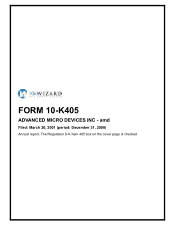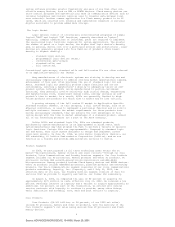AMD 2000 Annual Report Download - page 8
Download and view the complete annual report
Please find page 8 of the 2000 AMD annual report below. You can navigate through the pages in the report by either clicking on the pages listed below, or by using the keyword search tool below to find specific information within the annual report.-
 1
1 -
 2
2 -
 3
3 -
 4
4 -
 5
5 -
 6
6 -
 7
7 -
 8
8 -
 9
9 -
 10
10 -
 11
11 -
 12
12 -
 13
13 -
 14
14 -
 15
15 -
 16
16 -
 17
17 -
 18
18 -
 19
19 -
 20
20 -
 21
21 -
 22
22 -
 23
23 -
 24
24 -
 25
25 -
 26
26 -
 27
27 -
 28
28 -
 29
29 -
 30
30 -
 31
31 -
 32
32 -
 33
33 -
 34
34 -
 35
35 -
 36
36 -
 37
37 -
 38
38 -
 39
39 -
 40
40 -
 41
41 -
 42
42 -
 43
43 -
 44
44 -
 45
45 -
 46
46 -
 47
47 -
 48
48 -
 49
49 -
 50
50 -
 51
51 -
 52
52 -
 53
53 -
 54
54 -
 55
55 -
 56
56 -
 57
57 -
 58
58 -
 59
59 -
 60
60 -
 61
61 -
 62
62 -
 63
63 -
 64
64 -
 65
65 -
 66
66 -
 67
67 -
 68
68 -
 69
69 -
 70
70 -
 71
71 -
 72
72 -
 73
73 -
 74
74 -
 75
75 -
 76
76 -
 77
77 -
 78
78 -
 79
79 -
 80
80 -
 81
81 -
 82
82 -
 83
83 -
 84
84 -
 85
85 -
 86
86 -
 87
87 -
 88
88 -
 89
89 -
 90
90 -
 91
91 -
 92
92 -
 93
93 -
 94
94 -
 95
95 -
 96
96 -
 97
97 -
 98
98 -
 99
99 -
 100
100 -
 101
101 -
 102
102 -
 103
103 -
 104
104 -
 105
105 -
 106
106 -
 107
107 -
 108
108 -
 109
109 -
 110
110 -
 111
111 -
 112
112 -
 113
113 -
 114
114 -
 115
115 -
 116
116 -
 117
117 -
 118
118 -
 119
119 -
 120
120 -
 121
121 -
 122
122 -
 123
123 -
 124
124 -
 125
125 -
 126
126 -
 127
127 -
 128
128 -
 129
129 -
 130
130 -
 131
131 -
 132
132 -
 133
133 -
 134
134 -
 135
135 -
 136
136 -
 137
137 -
 138
138 -
 139
139 -
 140
140 -
 141
141 -
 142
142 -
 143
143 -
 144
144 -
 145
145 -
 146
146 -
 147
147 -
 148
148 -
 149
149 -
 150
150 -
 151
151 -
 152
152 -
 153
153 -
 154
154 -
 155
155 -
 156
156 -
 157
157 -
 158
158 -
 159
159 -
 160
160 -
 161
161 -
 162
162 -
 163
163 -
 164
164 -
 165
165 -
 166
166 -
 167
167 -
 168
168 -
 169
169 -
 170
170 -
 171
171 -
 172
172 -
 173
173 -
 174
174 -
 175
175 -
 176
176 -
 177
177 -
 178
178 -
 179
179 -
 180
180 -
 181
181 -
 182
182 -
 183
183 -
 184
184 -
 185
185 -
 186
186 -
 187
187 -
 188
188 -
 189
189 -
 190
190 -
 191
191 -
 192
192 -
 193
193 -
 194
194 -
 195
195 -
 196
196 -
 197
197 -
 198
198 -
 199
199 -
 200
200 -
 201
201 -
 202
202 -
 203
203 -
 204
204 -
 205
205 -
 206
206 -
 207
207 -
 208
208 -
 209
209 -
 210
210 -
 211
211 -
 212
212 -
 213
213 -
 214
214 -
 215
215 -
 216
216 -
 217
217 -
 218
218 -
 219
219 -
 220
220 -
 221
221 -
 222
222 -
 223
223 -
 224
224 -
 225
225 -
 226
226 -
 227
227 -
 228
228 -
 229
229 -
 230
230 -
 231
231 -
 232
232 -
 233
233 -
 234
234 -
 235
235 -
 236
236 -
 237
237 -
 238
238 -
 239
239 -
 240
240 -
 241
241 -
 242
242 -
 243
243 -
 244
244 -
 245
245 -
 246
246 -
 247
247 -
 248
248 -
 249
249 -
 250
250 -
 251
251 -
 252
252 -
 253
253 -
 254
254 -
 255
255 -
 256
256 -
 257
257 -
 258
258 -
 259
259 -
 260
260 -
 261
261 -
 262
262 -
 263
263 -
 264
264 -
 265
265 -
 266
266 -
 267
267 -
 268
268 -
 269
269 -
 270
270 -
 271
271 -
 272
272 -
 273
273 -
 274
274 -
 275
275 -
 276
276 -
 277
277 -
 278
278 -
 279
279 -
 280
280 -
 281
281 -
 282
282 -
 283
283 -
 284
284 -
 285
285 -
 286
286 -
 287
287 -
 288
288 -
 289
289 -
 290
290 -
 291
291 -
 292
292 -
 293
293 -
 294
294 -
 295
295 -
 296
296 -
 297
297 -
 298
298 -
 299
299 -
 300
300 -
 301
301 -
 302
302 -
 303
303 -
 304
304 -
 305
305 -
 306
306 -
 307
307 -
 308
308 -
 309
309 -
 310
310 -
 311
311 -
 312
312 -
 313
313 -
 314
314 -
 315
315 -
 316
316 -
 317
317 -
 318
318 -
 319
319 -
 320
320 -
 321
321 -
 322
322 -
 323
323 -
 324
324 -
 325
325 -
 326
326 -
 327
327 -
 328
328 -
 329
329 -
 330
330 -
 331
331 -
 332
332 -
 333
333 -
 334
334 -
 335
335 -
 336
336 -
 337
337 -
 338
338 -
 339
339 -
 340
340 -
 341
341 -
 342
342 -
 343
343 -
 344
344 -
 345
345 -
 346
346 -
 347
347 -
 348
348 -
 349
349 -
 350
350 -
 351
351 -
 352
352 -
 353
353 -
 354
354 -
 355
355 -
 356
356 -
 357
357 -
 358
358 -
 359
359 -
 360
360 -
 361
361 -
 362
362 -
 363
363 -
 364
364 -
 365
365 -
 366
366 -
 367
367 -
 368
368 -
 369
369 -
 370
370 -
 371
371 -
 372
372 -
 373
373 -
 374
374 -
 375
375 -
 376
376 -
 377
377 -
 378
378 -
 379
379 -
 380
380 -
 381
381 -
 382
382 -
 383
383 -
 384
384 -
 385
385 -
 386
386 -
 387
387 -
 388
388 -
 389
389 -
 390
390 -
 391
391 -
 392
392 -
 393
393 -
 394
394 -
 395
395 -
 396
396 -
 397
397 -
 398
398 -
 399
399 -
 400
400 -
 401
401 -
 402
402 -
 403
403 -
 404
404 -
 405
405 -
 406
406 -
 407
407 -
 408
408 -
 409
409 -
 410
410 -
 411
411 -
 412
412 -
 413
413 -
 414
414 -
 415
415 -
 416
416 -
 417
417 -
 418
418 -
 419
419 -
 420
420 -
 421
421 -
 422
422 -
 423
423 -
 424
424 -
 425
425 -
 426
426 -
 427
427 -
 428
428 -
 429
429 -
 430
430 -
 431
431 -
 432
432 -
 433
433 -
 434
434
 |
 |
system software provides greater flexibility and ease of use than other non-
volatile memory devices, such as ROM or EPROM devices. Flash memory devices can
store control programs and system-critical data in communication devices such as
cellular telephones and routers (devices used to transfer data between local
area networks). Another common application for Flash memory product is in PC
cards, which are inserted into notebook and subnotebook computers or personal
digital assistants to provide added data storage.
The Logic Market
Logic devices consist of structurally interconnected groupings of simple
logical "AND" and logical "OR" functions, commonly described as "gates."
Typically, complex combinations of individual gates are required to implement
the specialized logic functions required for system applications. The greater
the number of gates on a logic device, the higher that logic device's density
and, in general, device cost (for a particular process and architecture). Logic
devices are generally grouped into five families of products (from lowest
density to highest density):
. standard logic devices;
. programmable logic devices (PLDs);
. conventional gate-arrays;
. standard cells; and
. full custom ICs.
Conventional gate-arrays, standard cells and full-custom ICs are often referred
to as application-specific ICs (ASICs).
Many manufacturers of electronic systems are striving to develop new and
increasingly complex products to address evolving market opportunities rapidly.
Achievement of this goal often precludes the use of standard logic ICs and
ASICs. Standard logic ICs generally perform simple functions and are not
customizable, limiting a manufacturer's ability to adequately tailor an end-
product system. Although ASICs can be manufactured to perform customized
functions, they generally involve relatively high initial design, engineering
and manufacturing costs, significant design risks, and may increase an end-
product's time to market. As a result, ASICs are generally limited to high-
volume products and products for which time to market may be less critical.
A growing category of the full custom IC market is Application Specific
Standard Products (ASSPs). In this category, a full custom design, such as an
Ethernet controller, is used to implement a particular function and is sold to
multiple customers. Because the market requirements for these products have
become increasingly standard, they can achieve the cost advantages of full
custom design with the time to market advantages of a standard product. Almost
all of our networking products are a part of the ASSP category.
Unlike ASICs and standard logic ICs, PLDs are standard products,
purchased by system manufacturers in an unprogrammed or blank state. Each
system manufacturer may then program the PLDs to perform a variety of specific
logic functions. Certain PLDs are reprogrammable. Compared to standard logic
ICs and ASICs, PLDs allow system designers to design and implement custom
logic more quickly. On June 15, 1999, we sold Vantis Corporation (Vantis), our
PLD subsidiary, to Lattice Semiconductor Corporation (Lattice), and we now
function as a foundry and provide administrative services to Vantis.
Product Segments
In 2000, we participated in all three technology areas within the IC
market--microprocessors, memory circuits and logic circuits--through our Core
Products, Voice Communications and Foundry Services segments. Our Core Products
segment includes our PC processors, Memory products and Other IC products. PC
processors include AMD seventh-generation microprocessors and AMD-K6(R)
microprocessors. Memory products include Flash memory devices and EPROM devices.
Other IC products include embedded processors, platform products and networking
products. Our Voice Communications segment consisted of our voice communications
products subsidiary, Legerity, Inc. (Legerity), until July 31, 2000, the
effective date of its sale. Our Foundry Services segment consists of fees for
services that we provide to Legerity and Vantis, our former PLD subsidiary.
On August 4, 2000, we completed the sale of 90 percent of Legerity for
approximately $375 million in cash, effective July 31, 2000. We retained a ten
percent ownership interest in Legerity and a warrant to acquire approximately an
additional ten percent. As part of the transaction, we entered into various
service contracts with Legerity to continue to provide, among other things,
wafer fabrication and assembly, test, mark and pack services to Legerity.
Core Products
Core Products ($4.361 billion, or 94 percent, of our 2000 net sales)
include PC processor, memory and other IC products, with the majority of the
Core Products segment's net sales being derived from PC processors and Flash
memory devices.
4
Source: ADVANCED MICRO DEVIC, 10-K405, March 20, 2001
